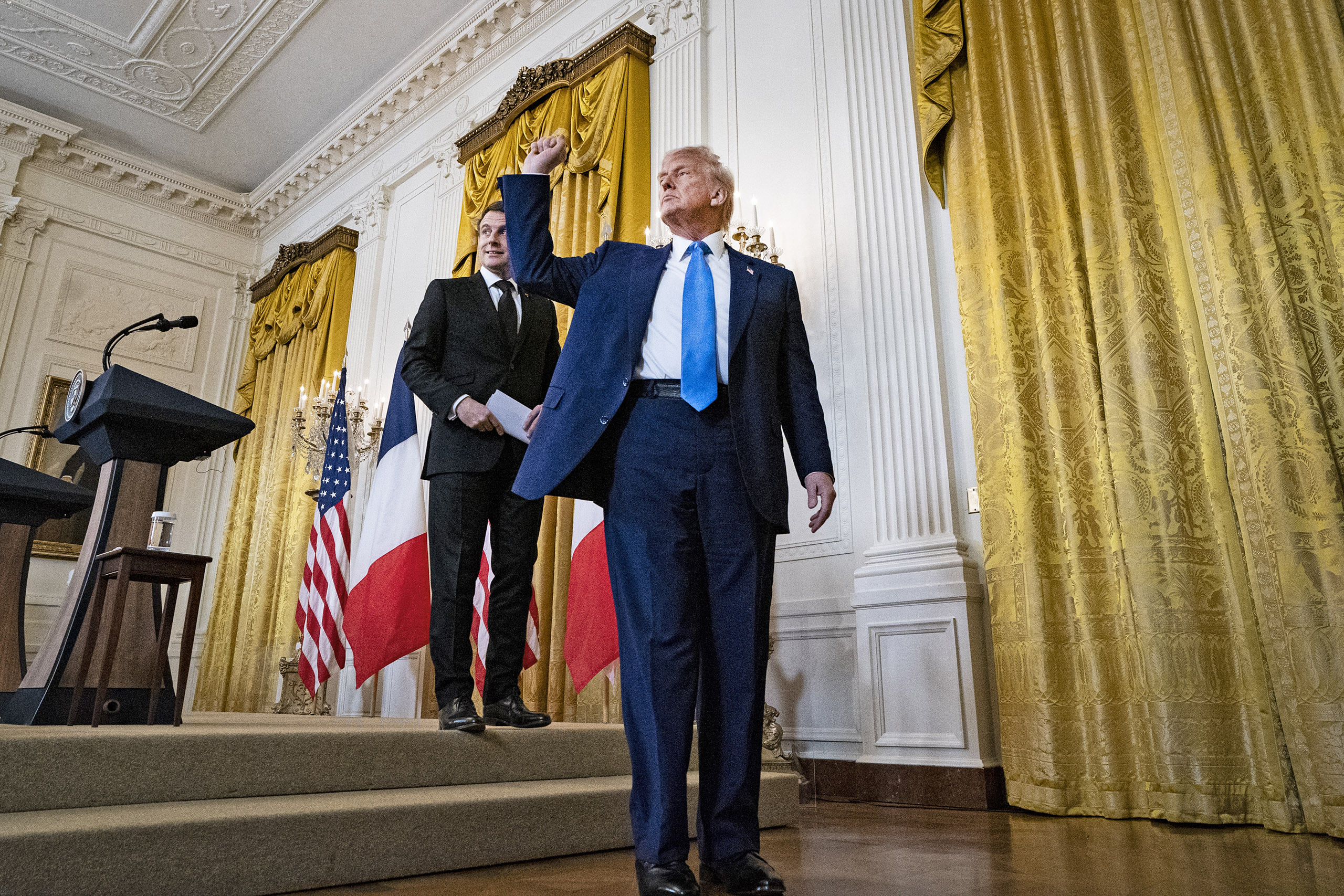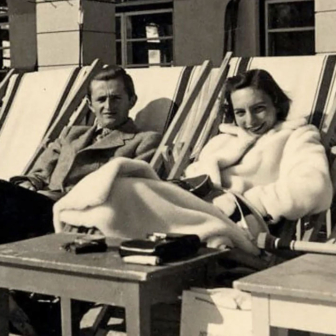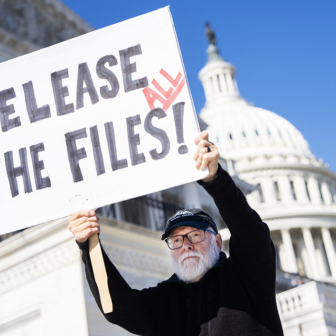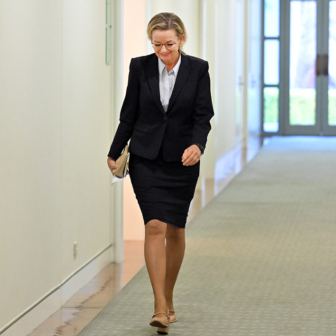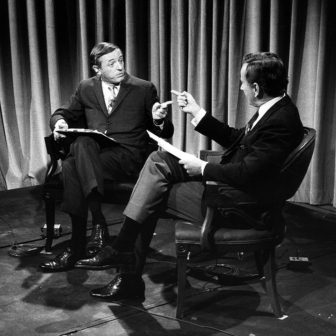Across the Western world and aligned countries in Asia the question on many minds is: Are the Americans still the good guys? Especially after the shocks delivered by Donald Trump’s representatives at Munich, can we still rely on them?
Even before Munich, one of Australia’s most respected foreign policy analysts, Peter Varghese, former head of Foreign Affairs and the federal government’s peak intelligence assessment body, was highlighting the baleful effect of Trump’s bullying of American friends big and small and his crudely extractive trade bargaining.
“Donald Trump may achieve what seventy-five years of postwar Americanism could not: concede the case for moral equivalence,” Varghese wrote in the Australian Financial Review. “Moral equivalence,” he added, “was the accusation that for all America’s claims to the ethical high ground, it was in practice no better than its authoritarian enemies.”
After the Munich shocks delivered by vice-president J.D. Vance, the sense of betrayal was too much for an equally respected figure, economist Saul Eslake. “Do we want to ally ourselves with a people who can knowingly choose people like Trump and Vance to lead them and to be the public face of their country presented to the rest of the world?” he wrote in Pearls & Irritations. These are “people who are willing to ‘cut deals’ with murderous dictators — in much the same way, albeit on a smaller scale, that mob bosses carved out territory in the boroughs of New York, where Donald Trump learned his trade under the tutelage of his father and the likes of Roy Cohn…”
Among politicians in Canberra and other US-allied capitals Trump’s approach is more politely referred to as “transactional.” But Chosun Ilbo, South Korea’s highest-circulation newspaper, is even less diplomatic than Eslake, labelling Trump a “mobster” and “grifter” who is creating “a jungle law international order blinded by self-interest and money.” According to an editorial last week, the US president is “blackmailing Gaza, Greenland, Panama and Canada like an organised crime syndicate.”
“He is what the anthropologists and scholars of ancient mythologies would call a trickster,” writes Michael Ignatieff, the writer and former Canadian opposition leader who until 2021 headed the George Soros–founded Central European University, based in Vienna after it was ousted from Budapest by the Hungarian pioneer of “illiberal democracy,” Viktor Orbán. “Tricksters intimidate and unsettle. Barbed humour is the weapon of choice. They have an instinct for what gets under the skin of opponents and a gift for keeping them off balance.” Hence Trump’s needling of the nice Canadians.
Political analysts usually wait the first hundred days to get a sense of where a new United States president is taking his administration. In Trump’s case, it’s clear after not much more than a month that he intends to break and disrupt an awful lot of systems and assumptions, as well as punishing those officials and critics who gave him legal and reputational strife between his two administrations.
Notable among his targets are the multilateral world trade order, a range of international cooperative efforts including the World Health Organization and the Paris climate change agreement and, at least in Europe, the post-1945 Pax Americana. His new secretary of justice, Pam Bondi, has halted application of the Foreign Corrupt Practices Act, thus signalling that American businesses are free to bribe overseas, and suspended her department’s “kleptocracy initiative,” which had been seizing the assets of Russian oligarchs and other corrupt figures.
But the world order Trump envisages is still hazy, perhaps even in his own mind. And other players are using Trump to push agendas he may discard or pursue.
Many of his goals track those of Project 2025, the manifesto put out by the ultra-conservative Heritage Foundation last year. Even though Trump disavows any connection, several of his key appointees — including Russell Vought (head of the Office of Management and Budget in the White House), Tom Homan (the “border czar”) and John Ratcliff (the new Central Intelligence Agency director) — helped write Project 2025.
The 900-page program aims to restore the family as the “centrepiece of American life,” dismantle the administrative state, defend the nation’s sovereignty and borders, and secure “God-given individual rights to live freely.” Along with banning the mailing of abortion pills over state lines, criminalising pornography, abolishing the education department, dumping a sweeping range of environmental regulations and cracking down on diversity programs, it would expand presidential power by boosting the number of political appointees and increasing the president’s authority over the justice department.
There is an urgency to this project. “History teaches that a president’s power to implement an agenda is at its apex during the administration’s opening days,” wrote its former director Paul Dans. Trump, with a stacked Supreme Court and Republican majorities in both houses of Congress (and Musk threatening to “primary out” any dissenters through weight of money in preselection campaigns), is a chance for unprecedented change.
Trump’s appointment of Tesla–X–SpaceX billionaire Elon Musk to an unofficial but empowered “Department of Government Efficiency” has started the demolition of the federal administrative state, with mass sackings and voluntary redundancy offers. Musk is part of an anarchic cabal of tech “bros” urging investment to keep America ahead of China in futuristic systems like AI and quantum computing.
The second group latching on to Trump are what analysts Jeremy Shapiro and Majda Ruge call the strategic “prioritisers” — those who think America’s main game is countering China and distractions like European defence should be ended or drastically scaled back. The key advocates are the defence department’s new policy head, Elbridge Colby, and secretary of state Marco Rubio.
This group is distinct from the “primacists” like Trump’s first-term CIA director and secretary of state Mike Pompeo, who once set a goal of removing Communist Party rule in China. Pompeo has been banished and his security detail removed on Trump’s orders. Likewise the “restrainers,” who would have confined the US sphere of influence to the Western Hemisphere in a new Monroe Doctrine. Some thought Trump’s early thoughts on annexing Greenland, Canada and Panama were part of such a new isolationism.
Rather than isolationist, Trump’s team are “unilateralists” or a “sovereigntists,” say international relations scholars like Clinton Fernandes at the Australian Defence Force Academy. “Their aim is an illiberal international geopolitical order where domestic political systems resemble ‘competitive authoritarianism,’ with multi-party elections embedded in a rigged legal and political environment,” says Fernandes. “Under this model, the media and the machinery of government are used to attack opponents and co-opt critics.”
Trump wants the United States to set the technical standards governing the global economy, he adds. “Control over these standards creates lock-in effects in finance, telecommunications, space, robotics, bioengineering, nanotechnologies, and advanced materials and manufacturing methods. That means full-spectrum rivalry with China. If economic control is not possible, the plan B goal is global economic separation from China.”
The clearest sign of prioritising is the removal of strategic assurances for Europe. Vance and new defence secretary Pete Hegseth have told Ukraine bluntly that Trump will pursue a peace settlement that involves Russia keeping the territory it has seized and Ukraine being kept out of Nato. The United States might give some protection to the rump Ukraine’s neutrality, but only in return for an extortionate share of its hydrocarbons, rare earths and lithium.
Vance (and Musk before him) also gave open support to the far-right Alternative für Deutschland in Germany’s elections last weekend while chiding West Europe for being soft on immigration and abandoning “some of its own fundamental values.” The AfD duly doubled its vote to 20 per cent, making the country’s the second-most-popular party.
After Munich, Rubio met Russian foreign minister Sergey Lavrov in Riyadh to start negotiations on a Ukraine settlement, with neither Ukraine nor the European Union invited. The two parties agreed to restore staffing at their respective embassies in Washington and Moscow, create a high-level team to support their Ukraine talks, and explore closer relations and economic cooperation. “Should this conflict come to an acceptable end,” said Rubio, “incredible opportunities… exist to partner with the Russians geopolitically on issues of common interest and frankly, economically on issues that hopefully will be good for the world and also improve our relations in the long term.”
With officials working towards an in-person meeting, Trump had a ninety-minute phone call with Vladimir Putin and later seemed to be repeating the Russian line on Ukraine. As former Kyiv and Moscow correspondent James Meek explained in the London Review of Books, Putin has essentially the same aims as were set out in the surrender draft Russian negotiators put to the Ukrainians in Istanbul in 2022. Putin still thinks Ukraine was ready to sign at the time but was talked out of it by Western “warmongers” like Britain’s Boris Johnson.
“Russia has already said that any Western peacekeeping force in Ukraine after a ceasefire is out of the question, but the Istanbul draft goes much further,” Meek wrote. “It demands that Ukraine renounce any defence treaties with other countries, forbid any foreign troops on its soil, give up any missiles or drones with a range of more than 155 miles and reduce its military to one-sixth of its pre-invasion size, with a skeleton force of only 1500 officers. The draft proposed that all Ukrainian units would return to barracks, with their disarmament supervised by Russia.”
Since the 2022 talks, Russia has declared five Ukrainian regions to be part of Russia. “Of these regions, it has complete control only of Crimea,” Meek wrote. “Will America back Russia in trying to force Ukraine to hand over these huge, heavily populated areas of free Ukraine, including the large cities of Kherson and Zaporizhzhia, to Putin, without a fight?”
Meeks also noted that “ousting Ukraine’s Zelensky and putting a pliable puppet in place in Kyiv has always been, and continues to be, one of Putin’s war aims.” Trump seemed willing to help out with his comments that Zelensky was a “dictator” with little popular support, afraid to hold an election. Only after global criticism did he walk back these claims.
Putin is also expected to demand the withdrawal of outside Nato troops from all the former Soviet states admitted to the treaty after 1990, effectively leaving the Baltic nations, Moldova and other countries at the mercy of Moscow.
Unsurprisingly, this reduction in American support for Ukraine has been received in Moscow “like Christmas, Easter, and New Year’s all rolled into one,” as Alexey Kovalev writes in Foreign Policy. For Europe it has been a bombshell, prompting an immediate emergency summit of German, French and British leaders. The location of the meeting, in Munich, drew immediate comparison with Neville Chamberlain’s 1938 agreement with Adolf Hitler, struck in that city, which allow the German dictator to take Sudetenland from Czechoslovakia as the price of “peace for our time.”
It is worse than that, says Keir Giles of the London think-tank Chatham House. “In some respects, the danger to Europe’s democracies today is greater, not less, than it was ninety years ago,” he wrote last week in the Financial Times. At least Britain and France were frantically re-arming in parallel with the 1938 appeasement. For decades, the Europeans have relied on American guarantees and run down their forces.
“The popular perception that Russia’s armed forces are incapable of harming Europe because they were eviscerated in Ukraine in 2022 has been slow to dissipate,” Giles wrote. “The fact that Russia’s land forces had been built back bigger by early 2024 is now more widely recognised — as is the way some Nato militaries have become not more but less capable since 2022 as a result of donations to Ukraine not being replaced in inventory.”
He went on: “Looking back at the 1930s, we used to wonder how it seemed that everybody could see war coming but do nothing to stop it. Now we understand, as we see the same mistakes repeated one after another. Instead, credible European deterrence of Russia is key to avoiding disaster. Europe has seen huge investment in countering terrorism by individuals and groups. What it needs now is also investment in countering state terror of the kind delivered by Moscow.”
Despite the European Union’s budget deficit limits and recruitment constraints, its member governments are being pushed into dealing with the Russian problem. Poland — which already spends 5 per cent of gross domestic product on defence and hosting US army units — is the big exception.
Excluding the Europeans from the Ukraine peace talks was not a plot against them, writes Jeremy Shapiro of the European Council on Foreign Relations, a think-tank: “It is yet another demonstration of Europe’s increasing geopolitical irrelevance.” To became relevant, Europe would have to front up with funds for reconstructing Ukraine, security guarantees (including stationed troops), and sanctions to keep up the pressure on Russia.
It’s not yet the withdrawal of the Roman legions, but Europe is realising it can no longer count on American protection. “We must be prepared for the fact that Donald Trump will no longer fully accept the promise of assistance under the Nato treaty,” said Friedrich Merz, the centre-right leader expected to became Germany’s chancellor after the election. Europeans now had to make every effort to gain the capacity to defend their continent on their own. Implicitly suggesting the US nuclear umbrella was no longer reliable, Merz also said he would seek talks with London and Paris “about whether nuclear sharing, or at least nuclear security from the UK and France, could apply to us.”
Could a “reverse Kissinger” be in play? Provoking Europe to take over its own defence would let the US step back from its European security role and make its long-promised pivot to Asia and focus on its main adversary, China, writes John Blaxland of the ANU’s Strategic and Defence Studies Centre. “Russia evidently features as part of this plan. Trump appears intent to try to cleave Russia from its Chinese embrace in order to either isolate or weaken China. A hard-nosed deal with Russia over Ukraine may well be the price he’s willing to pay to make that happen.” But could Putin ever be held to such a deal?
America’s allies in Asia are meanwhile wondering if they are in for the same treatment as Europe. “It is clear to all of us that we live in quite interesting times, that the assumptions that we have undertaken in last eighty years have now fundamentally changed,” Singapore’s defence minister Ng Eng Hen said after hearing Vance’s speech at Munich, adding — a little more robustly — that America’s image in Asia “has changed from liberator to great disruptor to a landlord seeking rent.”
After the Russian invasion three years ago, Japan became one of the biggest donors of non-lethal aid to Kyiv, but its conservative government also used the shock to greatly increase military spending, expand its own forces by reinterpreting the non-belligerency clause of its post-1945 constitution, and open military dialogues with Europe, South Korea and Australia.
Trump’s switch on Ukraine has put Japan in a dilemma, says long-time Japan-watcher Tobias Harris. “It will remain dependent for its security on a United States that has ostentatiously abandoned the international order that the Japanese government has articulated is vital for the defence of Japan’s national interests,” he writes, adding that Japan has been “sympathetic to — and committed to — the European countries left behind by the United States.”
Tokyo was appalled by the Vance and Hegseth messages in Munich. “It is important that a just and lasting peace be achieved as soon as possible with the full involvement of Ukraine as a party,” foreign minister Iwaya Takeshi declared, emphasising the importance of sovereignty and territorial integrity. A war that ends “with Russia seen as the victor… would send the wrong message not only to China but to the world.” In a hurried visit to Washington, Japanese prime minister Shigeru Ishiba managed to win a joint statement opposing attempts to “change the status quo by force or coercion” in the East and South China Seas and Taiwan Strait.
“Perhaps US allies in Asia can view this is a ‘hard pivot’ from Europe to Asia, the price of an ‘Asia First’ policy,” Harris writes. “But how do they know that Ukraine today won’t be Taiwan, South Korea, or Japan tomorrow?” Still falling short of defence spending demands by Trump officials like Elbridge Colby and knowing its wide US trade surplus to be in Trump’s sights, Tokyo’s resolve faces a test. “Would Japan be willing to invite US opprobrium — or worse — to oppose a US–Russia settlement that rewarded Russia, punished Ukraine, and left US allies in Europe alone to face Russia?”
Tokyo is not yet debating openly, as Berlin is now doing, whether it should develop an alternative nuclear deterrent, though in the recent past Ishiba has cited the need to stockpile fissile material as a reason to reopen nuclear power plants closed after the Fukushima disaster.
The same is not true for South Korea, though its immediate worries reflect Transactional Trump. The US president has demanded Seoul pay US$10 billion a year for the costs of the 28,000 American troops stationed in the south, up from the current US$1.2 billion, as a “tripwire” against North Korea. Korean companies will be heavily affected by the 25 per cent tariff threatened on US imports from Mexico, where Korean cars and electronics are assembled, as well as on direct imports of steel and aluminium.
The South Korean conservatives clinging to power despite the impeachment of their president for trying to impose martial law in December are deeply worried that Trump might resume his courting of the North’s dictator, Kim Jong-Un. They fear he will strike a deal that would involve withdrawing US forces in return for Kim promising to eliminate his nuclear capability, thereby putting the South at risk of a conventional blitzkrieg as happened in 1950. Veteran commentator Shim Jae Hoon says Trump’s sidelining of Ukraine has been badly received in Seoul. “Nothing is impossible from this dangerous man,” one government politician told him.
By contrast, South Korea’s leftist opposition Democratic Party is hoping Trump will do exactly that, and perhaps achieve a lasting peace with the North. Somewhat ahead of the game, it has nominated Trump for the Nobel Peace Prize.
The nuclear weapons debate has gone much further in South Korea than in Japan, says Sam Roggeveen, director of the Lowy Institute’s international security program. There, advanced missiles are already on land, surface ships and submarines, so far conventionally armed.
President Joe Biden’s administration attempted to renew “extended [nuclear] deterrence” in 2023 but jitters remain. “What I’d take away is real uncertainty and nervousness in Seoul that the United States is willing, in a crisis, to use nuclear weapons on South Korea’s behalf,” Roggeveen tells me. “So there is real erosion of US credibility in Korea.”
“The same would be true in Taipei — it would have to be,” he adds. “If you were in Taipei and watching Ukraine, you see a nuclear armed great power invading a smaller neighbour — that’s pretty analogous to the problem the Taiwanese face. The Americans are doing an awful lot on Ukraine’s behalf. They sent arms, they imposed sanctions on Russia, gave diplomatic support, intelligence support. But one thing they haven’t done is commit troops. If I was Taiwanese, I’d be drawing the lesson there: we’d get a lot of help from America but we won’t get the exact help we’ve really depended on. Especially none from a Trump administration.”
What does it all mean for Australia? Treasurer Jim Chalmers has gone to Washington to plead for an exemption from Trump’s tariff threats on the grounds of running a big bilateral trade deficit and being a good military ally.
In the strategic relationship, some share the South Koreans fears that Trump might be tempted into deals with North Korea’s Kim or China’s Xi Jinping, unravelling the entire post-1945 setting in Northeast Asia. But others, like ADFA’s Fernandes, see this as highly unlikely. They believe that America’s allies there, including Taiwan, will be seen as vital sentinels keeping China confined behind the “first island chain” and its closely monitored exit channels to open seas.
In Canberra, the bipartisan consensus sees Australia playing a part in this strategy through the ambitious AUKUS nuclear-powered submarine acquisition. Anxious to lock in Trump, defence minister Richard Marles went to Washington with a $800 million down-payment on the US$3 billion (A$4.7 billion) Canberra has promised to help expand US submarine-yard capacity. He seems to have got no assurance that Trump would not ask for more. Asked if the US would deliver the three to five attack submarines in the 2030s, as envisaged under AUKUS, Hegseth said: “I sure hope so.”
It looks unlikely. “Between now and 2032 the US Navy will drop from forty-nine nuclear powered attack submarines (SSNs) to thirty-two to thirty-five,” says retired Australian admiral Peter Briggs, a former submarine commander. “The US will not have sufficient SSNs to be able to sell Australia three to five Virginia Class submarines.”
“It’s not clear whether in formal terms this will land on Trump’s desk in the next four years,” says Lowy’s Roggeveen. “But some other preliminary decisions might cross his desk, not the actual sub transfer. If that happens and the national security adviser or whoever is briefing him on that day says that for Australia to get these three to five submarines we [the United States] are going to have to do with three to five fewer submarines — if the bargain is presented to him in those terms, I think the danger is that he will say no.”
On the issue of moral equivalence, many members of the Australian services will be wondering about the ally with which they are increasingly integrated. Hegseth has fired the US military’s judge advocates-general, the three-star military lawyers charged with keeping US forces to the rules of conflict. Hegseth wants to restore a “warrior ethos” among soldiers less restricted by the rules. Trump has sacked the chairman of the joint chiefs of staff, General Charles Q. Brown, the second Black American in the job, as well as the first women to lead the navy and the coast guard, Admiral Lisa Franchetti and Admiral Linda Lee Fagan, on the grounds they obtained their posts through now-abandoned diversity, equity and inclusion policies.
On Ukraine and the Middle East, the Albanese government stands with Europe rather than America. Defence sources say the transfer of the Australian army’s older-model Abrams heavy tanks to Ukraine is going ahead this year. Support for the International Criminal Court, threatened with sanctions by Trump, is strong. With recruitment falling behind, the Australian forces need to be inclusive as possible.
The jitters in Canberra’s intelligence agencies, meanwhile, can only be imagined. As Kori Schake of Washington’s conservative American Enterprise Institute points out, they and other Five Eyes intelligence partners are increasingly worried about sharing secrets with the United States. Trump’s new director of national intelligence, Tulsi Gabbard, is an inexperienced wildcard. His administration has offered career-ending buyouts to all CIA staff. Employee information has been put on vulnerable internet connections. The state department office watching out for foreign state-sponsored disinformation has been closed, the Department of Homeland Security has put staff working on foreign influence operations on administrative leave, and the FBI has closed its foreign-influence taskforce. The National Security Agency will likely be next, Schake thinks. All this goes back to Trump’s resentment at investigations into the extent of Russian help for his election in 2016.
Canberra’s US-alliance supporters are “a little shell-shocked,” says Roggeveen. “I wouldn’t expect any kind of public reversal. That’s a bit too painful for anyone to conduct.” But he finds it extraordinary that Trump’s humiliation of Canada and its prime minister Justin Trudeau passed so quietly in Australia.
“When Trudeau addressed the nation, it sounded like a wartime speech,” Roggeveen said. “At one point, in almost a pleading tone, he invokes Canadian wartime shared sacrifice with the United States. And the terminology and the imagery of that section of the speech is almost exactly what you hear one Australian prime minister, foreign minister and defence minister after another say about the US alliance: sacrifice, mateship, we fought together in every war. When you hear it come out of Trudeau’s mouth in those circumstances, you wonder: how much comfort can we now take from that sentiment? The alliance tragics must be thinking: that sentimentality, that values-based alliance, as they would call it, is a fantasy.”
Paul Dibb, the former defence deputy secretary and ANU strategist, sees different implications of the prioritising of China. “It’s not for me to underrate what’s happening in Europe, but for us it’s not all woe and doom,” he told me. If the biggest threat is China, Australia is now much more important in terms of its geographical position than it was when the Cold War was centred on the Northern Hemisphere. With US forces in Guam, Okinawa, Japan and South Korea vulnerable to Chinese conventional missiles, Australia offered a “geopolitical position sufficiently far back, short of nuclear war, to be a massive, stable base for American forward positioning.”
And as Fernandes and others note, whether analysts doubt American assurances and urge greater self-reliance or see a need to do more to keep the Americans happy, their remedy is the same: spend much more on defence. Either way it’s a win for the military–industrial complex.
And these are just the early weeks of Trump’s presidency — though Roggeveen isn’t sure the new administration will keep up the pace. “And exactly how close are Trump’s actions to his rhetoric?” he adds. “At the moment there’s only a vague association between them.” Other centres of power — the surviving bureaucracy, the courts — will impose themselves, as might a big scandal or a natural disaster like Hurricane Katrina, which hit the second George W. Bush administration. By the congressional midterms, a second-term president becomes a lame duck. “I’m cautious about projecting forward this first month and saying this is it for the next four years.”
For all the wild adulation Trump and the chainsaw-wielding Musk got at last week’s Conservative Political Action Committee festival, their policies are copping a backlash. As US historian Heath Cox Richardson notes, the honeymoon is already over. A new Washington Post/Ipsos poll shows majorities disapproving of the “the way Donald Trump is handling his job as president,” and of specific policies including abolishing USAID, tariffs on imports from Canada and Mexico, dismissal of federal employees, and deportation of undocumented immigrants with US-born children. The pardon for the 6 January rioters is especially unpopular, opposed by 83 per cent.
Maybe Eslake’s disillusionment with Americans is premature. But it’s going to be a long four years. •
 Funding for this article from the Copyright Agency’s Cultural Fund is gratefully acknowledged.
Funding for this article from the Copyright Agency’s Cultural Fund is gratefully acknowledged.
